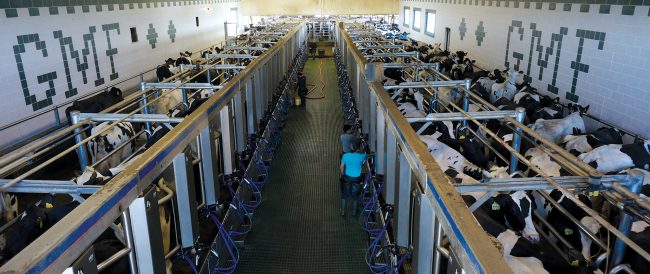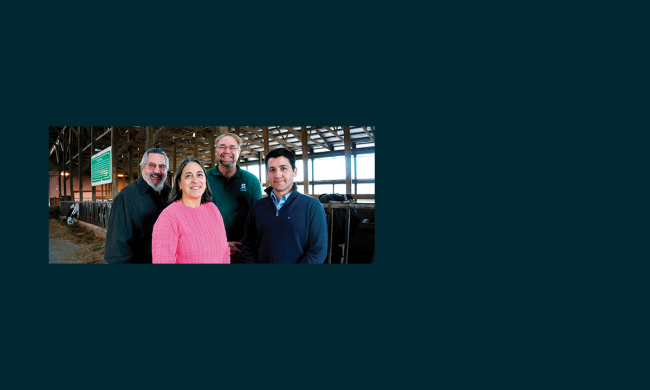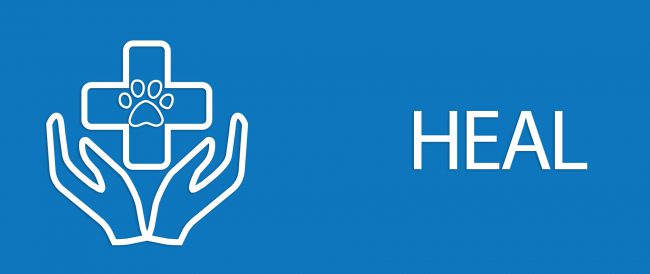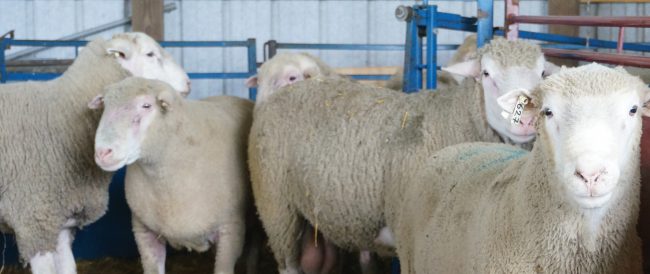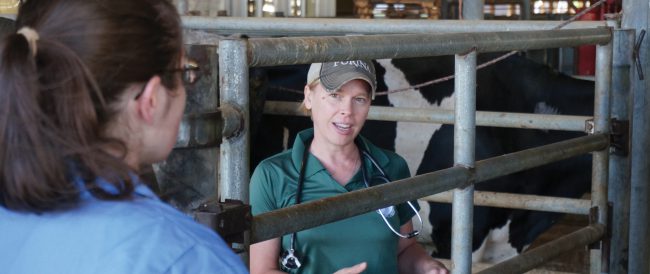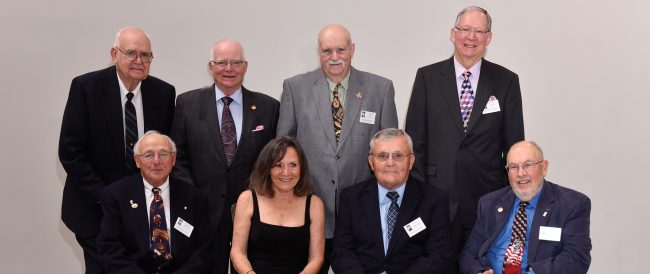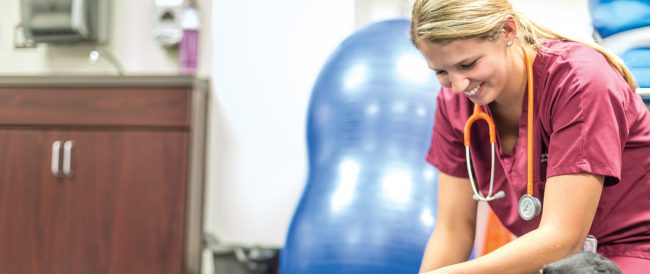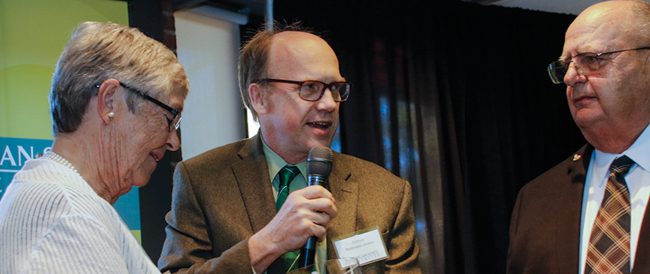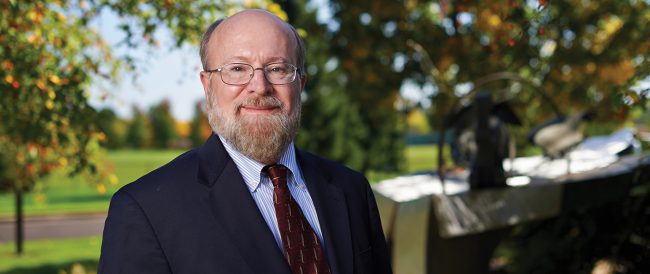 Read More
Read More
College and farm partner to improve veterinary education and the dairy industry of tomorrow.
Crop fields are a typical feature of almost any rural countryside. Surrounded by miles of crops in Elsie, Michigan sits Green Meadow Farms. On site, there’s a small, white building nestled between large dairy barns. This is Michigan State University’s Training Center for Dairy Professionals. It is run by Dr. Lou Neuder, associate professor for MSU’s Department of Large Animal Clinical Sciences. He is the director of the Center, which is a partnership between MSU and Green Meadow Farms that he helped facilitate with Drs. Dave Sprecher and Tom Herdt in the 1990s.
“I started working on the farm in ’94—I had a dairy practice in St. Johns, and my work brought me here,” says Neuder, an alumnus of the MSU College of Veterinary Medicine. “One of the senior members of the farm at that time, Duane Green, said to me, ‘Doc, if you always take care of the cows like they were your own, then we’ll get along just fine.’” That’s the mindset of the family, to always put the cows first.”
“The technology and methods used at this farm—not just during the milking process, but throughout the lives of the cows—facilitate an invaluable learning environment that focuses on cow comfort, dairy production, and food safety.”
— Dr. Lou Neuder
Since 1922, Green Meadow Farms has passed down through three generations of the Green family. Today, the farm milks approximately 3,500 cows three times per day, every day. This produces 300,000 pounds—or 37,500 gallons—of milk every 24 hours. It takes around 15 minutes to milk each cow. The milk shoots down into a transfer pipe at 95 degrees Fahrenheit. It travels through a cooling chamber and out of the building at a chilly 34 degrees, where it loads directly into a tanker truck. This transfer process takes roughly 30 seconds.
“The technology and methods used at this farm—not just during the milking process, but throughout the lives of the cows—facilitate an invaluable learning environment that focuses on cow comfort, dairy production, and food safety,” says Neuder.
The milk is sold through the Michigan Milk Producers Association and shipped to dairy companies. Then, in accordance with the Federal Milk Order, the milk is priced according to how it is used—fluid milk; soft manufacturing, such as ice cream or yogurt; hard manufacturing, such as cheese; or butter and non-fat dry powder. Pricing for each category is largely dependent on how easy it is to transport the product and how long it stores.
“Rotating through Green Meadow Farms allows our students not only to learn about the care of dairy cattle, but also the dairy industry,” says Neuder. “It’s part of what makes this rotation such a valuable experience for our students.”
Every DVM student at the MSU College of Veterinary Medicine comes to the Training Center for Dairy Professionals at Green Meadow Farms for at least one two-week rotation. Each day starts at 7:30 a.m. in the box stalls. Students conduct physical exams under Dr. Jill Brester’s guidance as she talks them through the ruling-out of specific problems. Brester is an assistant professor for the College, and plays a key role in every student’s experience at the farm.
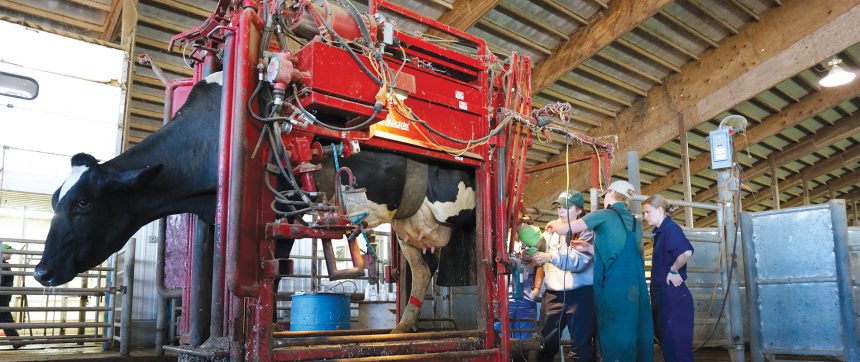
“Students need to get their hands on the cows so they can recognize normal from abnormal,” says Brester. “That’s a huge part of our teaching philosophy here, and it’s why physical exams kick off our morning, every morning.”
Armed with their pre-assessment notes, students hit the books to research their cases. Rounds start at 9:00 a.m. sharp; at this time, students discuss their cases and develop treatment plans with the help of Brester and Neuder. The morning wraps up with treatments. These include medications, hoof exams, pregnancy checks, surgery prep, and surgical procedures.
Darcy and Craig Green, co-owners of the farm, see the inherent value of the direct exposure that MSU students receive while working with the cows—a benefit not only to the students, but also the cows and the dairy industry.
“We are continually encouraged by our partnership with the MSU Training Center for Dairy Professionals,” says Darcy Green. “The opportunity to help train large animal veterinarians not only benefits our farm, but every other dairy farm in the nation. By giving the students a chance to be hands-on with not only sick cows, but healthy cattle of all ages, we are helping them become the best veterinarians they can be. With outstanding veterinarians, we give the dairy industry a chance to thrive and each cow a chance to live a healthy,
productive life.”
On one specific morning, a cow presents with gait problems, which could indicate lameness. Brester works with the students and resident hoof trimmer to load her into the trimming chute for evaluation. Here, the students get another hands-on learning opportunity. “What do you think?” Neuder asks from the background.
“If she walks better, she can go to 14,” Brester calls over the gate, referencing a separate area on the farm. Brester and the students treat an ulcerated corn between the cow’s toes, which could become infected if left unattended. The team debrides and wraps the cow’s hoof. Then, they lower the cow down and release her. She hobbles a bit, but with a much improved gait. Brester and the students grin and flash a thumbs up to Neuder before herding the cow off to 14. Neuder turns to his fellow observers and points to the chute.
“For your next pedicures,” he jokes

Students aren’t the only ones learning. Neuder says the role of food animal veterinarians is shifting from an exclusive focus on sick animals to one that now includes educating farm employees. On a dairy farm, that translates to herd management.
“It’s key that food safety starts inside the farm gates,” says Neuder. “It’s not just about treating sick cows anymore. Now, we’re an integral member of the herd management team. One of our skill sets is to be able to work with the farm—the employees, managers, and owners—to help teach about health issues and proper care of cows.”
Having this sort of cohesive team enables the farm to function effectively and efficiently. For a profit-driven company, that function is key, but it is not limited to production numbers; it includes supporting the producers. It is more economically feasible to treat one sick cow than to mitigate wide-spread loss in herd animals. To that point, students learn how proper cow care ties into food safety, animal welfare, and herd performance, and how to apply those values as a future teacher of farm employees who may not have been trained to work with animals.
“This is how we help to protect the food supply—it’s really about problem solving,” says Neuder. “It’s using our training and looking at a problem, understanding it, assessing it, and coming to a conclusion that identifies the causative risk factors. Then, we develop an action plan that includes the human element.”
Creating and maintaining a bond between humans and cows is not automatic. Veterinarians, who are versed in the microbiology of milk quality and bovine physiology, act as interpreters between the species by collecting data that supports evidence-based medical practice and decision making. This is the way Neuder and Brester teach their students to evaluate cases, make recommendations, implement practices, and ensure follow-up.
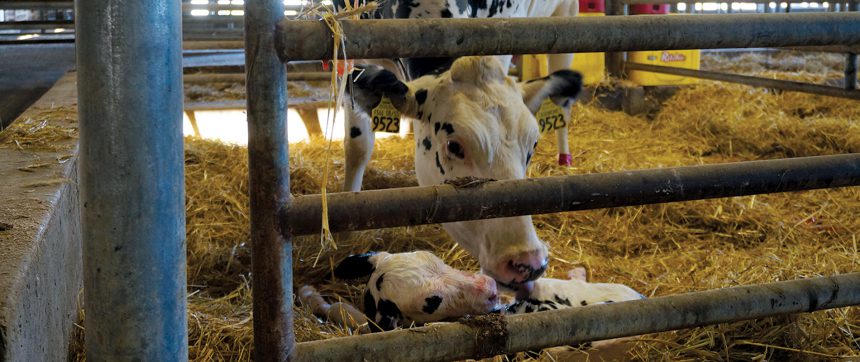
“It’s about monitoring systems, and that often includes employees,” says Neuder. “Everything we do is done in a person-cow interaction, so we’re always working to improve that interaction.”
That interaction also includes consumers.
“There’s a huge interest from the general public about where their food comes from,” says Neuder. “Many people don’t know, and there are a lot of misconceptions. But we’re the science officers in a lot of these operations. We understand food safety. We understand microbiology. We understand animal welfare. So, we’re often the source of information for clients, and that’s where the teaching component comes in.”
Neuder says that having experience working with cows on a modern dairy farm gives students the capability to advocate for the dairy industry, both in what the industry does and how it functions.
“In a perfect world, I’d have a big, old tree out here and a nice pasture and a big, white fence,” Neuder says. “And every evening when the sun was going down, I’d take my glass of milk and go sit on the fence and just look at my cows. Unfortunately, we can’t afford to do that, the farm can’t afford to do that. So, we use our skills and knowledge as veterinarians to provide proper care for our animals.
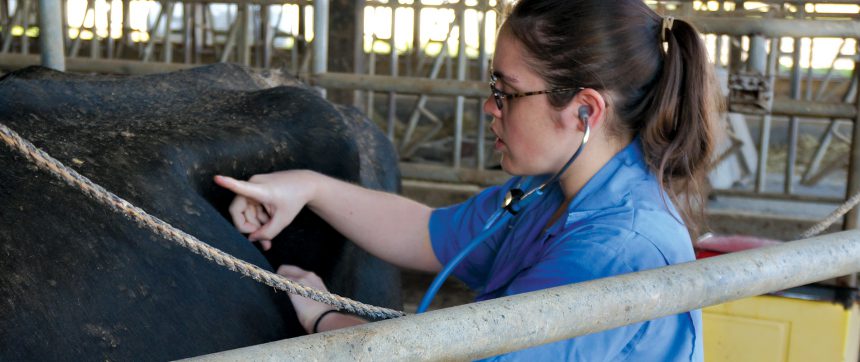
Around mid-morning, Lora Gurley, a fourth-year DVM student, walks across a large lot to the barn on the eastern side of the property. Another calf is about to be born.
“We can have up to 30 calves born in one day,” she says. Gurley has a Master’s degree in public health. Once she earns her DVM, she will work to protect animal, human, and environmental health by joining Veterinary Services under the Animal and Plant Health Inspection Service branch of the US Department of Agriculture. There, she will focus on disease surveillance, preparedness, and response.
“It’s a lot of herd-level surveillance and making sure we’re prepared for an animal disease outbreak, and not only that we are prepared, but that we’re able to respond to it,” Gurley says. “Our main goal is population health. For the most part, we’re looking at management-level issues—nutrition, disease patterns, reproductive problems, vaccination schedules. We want to prevent having to do individual animal medicine. By doing that, we can see a lot of changes at the herd level, and that is what’s most rewarding.”
As a DVM student, it would be easy for Gurley to miss out on learning more about the treatment of individual cows—but not at Green Meadow.
“In my field of study, there is not as much individual animal medicine; what’s nice about being here at Greens is that I do get to experience a focus on individual animal medicine,” Gurley says. “That knowledge base adds to what I’ll bring to the table when looking at an entire herd.”
Inside the barn, it is dark and cool. In one of the center-most stalls on a bed of fresh straw, a mother cow licks her new calf.
“Ah, well,” Gurley says. “There will be another.”
When there is down time in the afternoons, sessions are held at the classroom in the MSU Training Center for Dairy Professionals. The students watch cow handling videos, attend lectures about techniques and other farm topics, and review case studies. Brester, who interned with Neuder through MSU, knows well the value of bovine education inside and outside the classroom for students interested in working with any species of animal.
“So many students who come up here have never worked on cows and will never work with cows again,” says Brester. “But learning simple observation and examination techniques can help them better practice medicine across species. They need to get their hands dirty.”
“It was my dream to build this,” says Neuder. “If we want good students, we have to give them the opportunity to learn.”
Velmar Green, second generation co-owner of Green Meadow Farms, intends to continue that opportunity.
“I am proud of the relationship we’ve had with MSU, and the training Green Meadows has provided over the years,” says Velmar Green. “We’ve played a crucial role in helping prepare future dairy veterinarians, and with MSU faculty and students on-site, we know our animals will receive the best care. Our partnership is better for the cows, it’s better for production, and it’s better for the public who will be consuming the products.”



